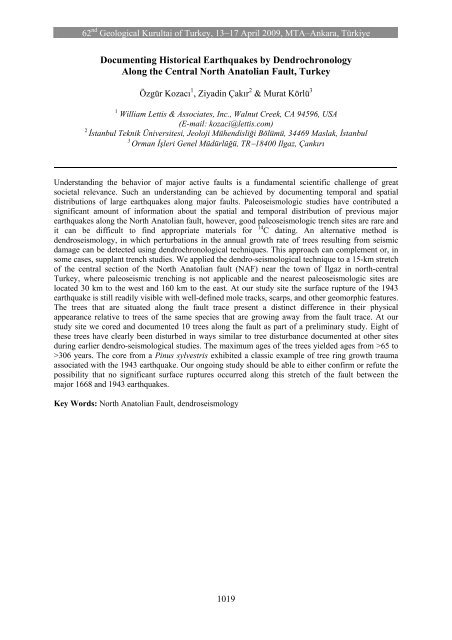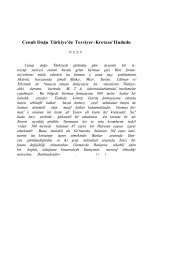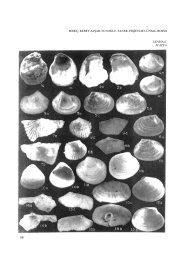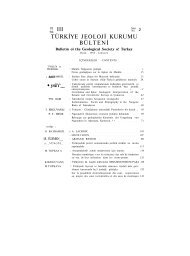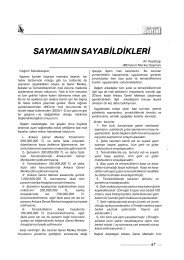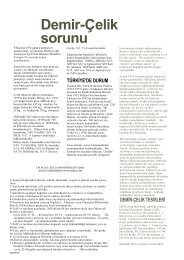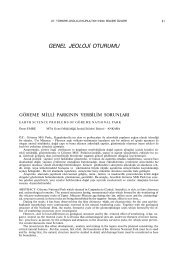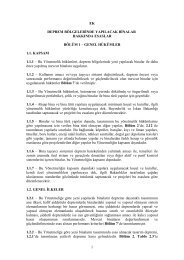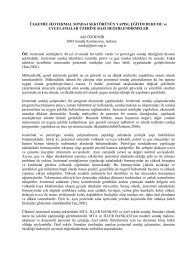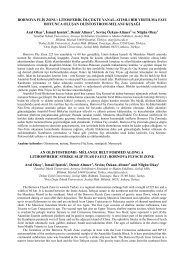Paleosismoloji ve Arkeosismoloji Palaeoseismology and ...
Paleosismoloji ve Arkeosismoloji Palaeoseismology and ...
Paleosismoloji ve Arkeosismoloji Palaeoseismology and ...
You also want an ePaper? Increase the reach of your titles
YUMPU automatically turns print PDFs into web optimized ePapers that Google loves.
62 nd Geological Kurultai of Turkey, 13−17 April 2009, MTA–Ankara, Türkiye<br />
Documenting Historical Earthquakes by Dendrochronology<br />
Along the Central North Anatolian Fault, Turkey<br />
Özgür Kozacı 1 , Ziyadin Çakır 2 & Murat Körlü 3<br />
1 William Lettis & Associates, Inc., Walnut Creek, CA 94596, USA<br />
(E-mail: kozaci@lettis.com)<br />
2<br />
İstanbul Teknik Üni<strong>ve</strong>rsitesi, Jeoloji Mühendisliği Bölümü, 34469 Maslak, İstanbul<br />
3<br />
Orman İşleri Genel Müdürlüğü, TR−18400 Ilgaz, Çankırı<br />
Underst<strong>and</strong>ing the behavior of major acti<strong>ve</strong> faults is a fundamental scientific challenge of great<br />
societal relevance. Such an underst<strong>and</strong>ing can be achie<strong>ve</strong>d by documenting temporal <strong>and</strong> spatial<br />
distributions of large earthquakes along major faults. Paleoseismologic studies ha<strong>ve</strong> contributed a<br />
significant amount of information about the spatial <strong>and</strong> temporal distribution of previous major<br />
earthquakes along the North Anatolian fault, howe<strong>ve</strong>r, good paleoseismologic trench sites are rare <strong>and</strong><br />
it can be difficult to find appropriate materials for 14 C dating. An alternati<strong>ve</strong> method is<br />
dendroseismology, in which perturbations in the annual growth rate of trees resulting from seismic<br />
damage can be detected using dendrochronological techniques. This approach can complement or, in<br />
some cases, supplant trench studies. We applied the dendro-seismological technique to a 15-km stretch<br />
of the central section of the North Anatolian fault (NAF) near the town of Ilgaz in north-central<br />
Turkey, where paleoseismic trenching is not applicable <strong>and</strong> the nearest paleoseismologic sites are<br />
located 30 km to the west <strong>and</strong> 160 km to the east. At our study site the surface rupture of the 1943<br />
earthquake is still readily visible with well-defined mole tracks, scarps, <strong>and</strong> other geomorphic features.<br />
The trees that are situated along the fault trace present a distinct difference in their physical<br />
appearance relati<strong>ve</strong> to trees of the same species that are growing away from the fault trace. At our<br />
study site we cored <strong>and</strong> documented 10 trees along the fault as part of a preliminary study. Eight of<br />
these trees ha<strong>ve</strong> clearly been disturbed in ways similar to tree disturbance documented at other sites<br />
during earlier dendro-seismological studies. The maximum ages of the trees yielded ages from >65 to<br />
>306 years. The core from a Pinus syl<strong>ve</strong>stris exhibited a classic example of tree ring growth trauma<br />
associated with the 1943 earthquake. Our ongoing study should be able to either confirm or refute the<br />
possibility that no significant surface ruptures occurred along this stretch of the fault between the<br />
major 1668 <strong>and</strong> 1943 earthquakes.<br />
Key Words: North Anatolian Fault, dendroseismology<br />
1019


